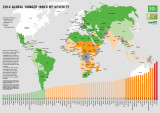Subsidized childcare and working women in urban Guatemala
With increasing urbanization, the percentage of women participating in the labor force and the percentage of households headed by single mothers have increased. Reliable and affordable child-care alternatives are thus becoming increasingly important in urban areas. The Hogares Comunitarios Program (HCP) was established in Guatemala City in 1991 as a direct response to the increasing need of poor urban dwellers for substitute childcare.











